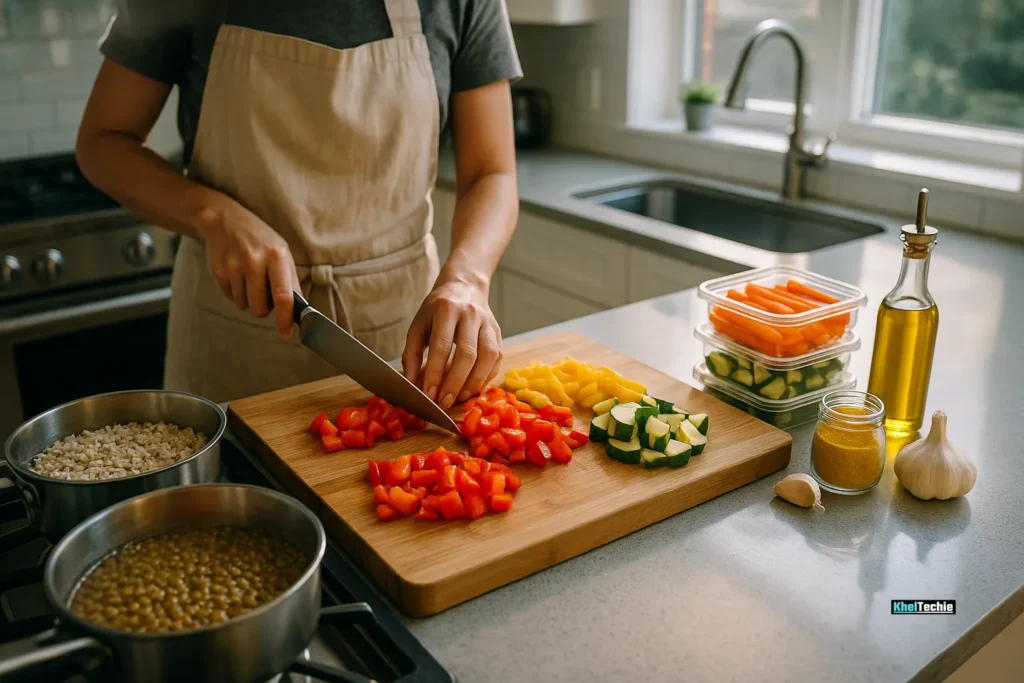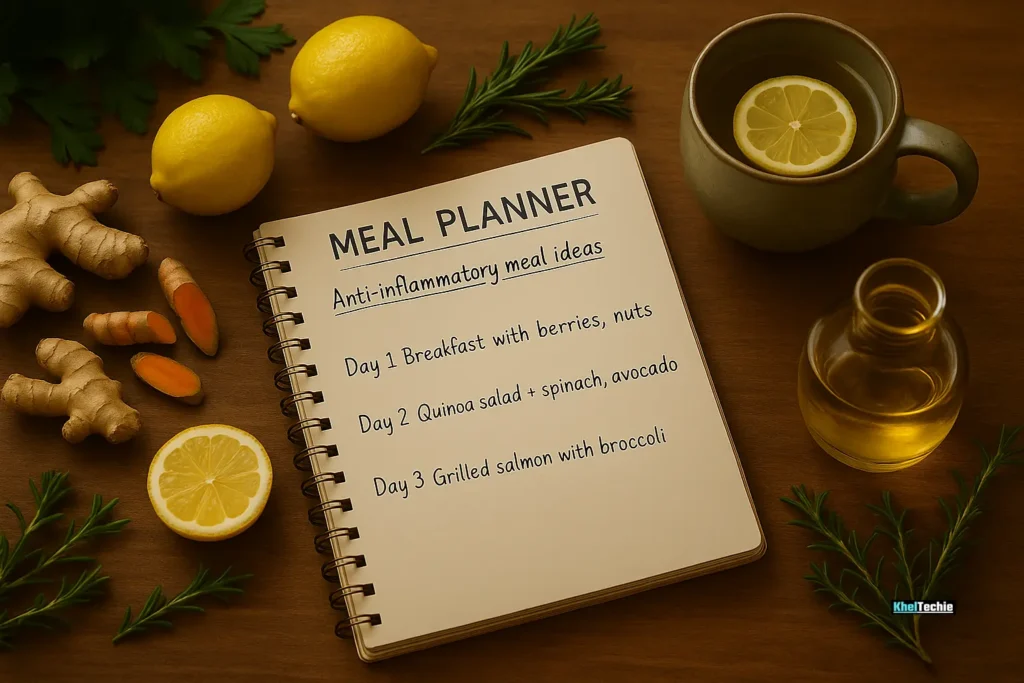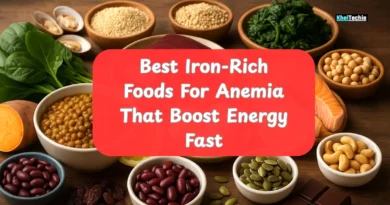Anti-Inflammatory Diet Meal Plans: 7-Day Guide to Reduce Inflammation & Feel Better Fast
You’re Not Alone in This Struggle!
You wake up stiff, your joints ache and even after a full night’s sleep you feel like you’ve run a marathon, Maybe you’ve tried multiple diets, but nothing seems to stick or worse, nothing helps you feel better.
This isn’t just about weight loss anymore, It’s about feeling good from the inside out. That’s where anti-inflammatory diet meal plans come in, not as a quick fix, but as a lifestyle shift that can change how your body responds to stress, food, and aging.
Let’s walk through what these meal plans really mean, why they work, and how you can start today without breaking the bank or losing your sanity.
Also read – Best Plant-Based Protein Sources

What Is an Anti-Inflammatory Diet Meal Plan?
An anti-inflammatory diet meal plan is a structured eating approach designed to reduce chronic inflammation in the body. Unlike crash diets, this focuses on nutrient-dense, whole foods that support cellular health and combat systemic inflammation linked to conditions like arthritis, heart disease, diabetes, and even depression.
Imagine your body is like a slow-burning fire, some foods fan the flames, others help ease them down. An anti-inflammatory meal plan is simply choosing ingredients that calm the fire inside you. Think olive oil over fried food, berries instead of candy, salmon instead of sausage.
Recent research shows diets rich in polyphenols (found in fruits, legumes, even chocolate) can inhibit inflammatory enzymes. Templates like EatingWell’s 7‑day plan feature balanced meals across whole grains, nuts, lean proteins, vegetables, and spice blends like turmeric and ginger, providing practical structure you can actually follow.
Core Principles:
- Prioritize plant-based foods rich in antioxidants
- Use healthy fats like olive oil and avocados
- Limit processed sugars, refined grains, and trans fats
- Include lean proteins and omega-3-rich fish
- Stay hydrated and limit alcohol

Why Anti-Inflammatory Meal Plans Matter
We know inflammation creeps up in sneaky ways. Here’s what two recent studies reveal and why your meal planning matters.
First, forget juice-only cleanses. According to a Northwestern University study, a three-day juice fast can hurt your gut. It feeds harmful bacteria while starving beneficial microbes. Those shifts don’t flip overnight, they linger for up to two weeks, increasing inflammation and possibly affecting your mental clarity. Fiber-rich, plant-based whole foods, on the other hand, do the opposite.
Second, brain health isn’t locked in by your age. The large-scale MIND diet study, tracking over 92,000 people, found a 25% lower Alzheimer’s risk when folks embraced leafy greens, berries, nuts, fish, and olive oil. According to the research, the MIND diet’s anti-inflammatory and antioxidant strengths make it a powerful tool, even if you start later in life.
So here’s the bottom line, Smart anti-inflammatory meal plans go way beyond trendy cleanses. They’re about fueling your gut, protecting your brain, and supporting long-term wellness. And guess what? According to science, real food meals built on whole, colorful ingredients truly make the difference.

Step-by-Step Guide to Creating Your Anti-Inflammatory Meal Plan
Step 1: Know What to Eat and What to Avoid
| Eat More Of | Avoid or Limit |
|---|---|
| Leafy greens (spinach, kale) | Processed meats (hot dogs, sausages) |
| Berries (blueberries, strawberries) | Refined carbohydrates (white bread, pastries) |
| Fatty fish (salmon, sardines) | Sugary drinks and snacks |
| Nuts and seeds (walnuts, flaxseeds) | Trans fats (fried foods, margarine) |
| Olive oil and avocado oil | Excessive alcohol |
| Herbs and spices (turmeric, ginger) | Artificial additives |
Step 2: Build Balanced Meals Around Whole Foods
Each meal should include:
- Protein: Grass-fed beef, wild-caught fish, tofu, legumes
- Healthy Fat: Avocado, nuts, olive oil
- Fiber: Vegetables, fruits, whole grains
- Antioxidants: Bright-colored produce like bell peppers, carrots, blueberries
Step 3: Plan Weekly Template
- Snacks: Fruit, nuts, veggie sticks, herbal tea
- Breakfast: Whole grain + berries + nuts or Greek yogurt smoothie
- Lunch: Grain, veggie bowl with lean protein + olive oil
- Dinner: Fatty fish/legumes + colorful vegetables + healthy fat
Step 4: Meal Prep Efficiently
- Cook staples (grains, proteins) once a week
- Prep veggies in advance
- Use spice blends (e.g., turmeric garlic)
- Portion by day into containers
- Freeze extras
Step 5: Hydrate Smartly
Swap sugary drinks for:
- Herbal teas (ginger, turmeric)
- Infused water (lemon, cucumber, mint)
- Green smoothies with leafy greens
Step 6: Track Inflammation & Adjust
Watch how you feel, energy, joint pain, digestion. Adjust macros/calories & add variety, You’ll eventually own your personalized version.

7-Day Anti-Inflammatory Diet Meal Plan
| Day | Breakfast | Lunch | Dinner | Snacks |
|---|---|---|---|---|
| Mon | Chia pudding with berries | Quinoa salad with chickpeas & spinach | Baked salmon with roasted broccoli | Apple slices with almond butter |
| Tue | Veggie omelet with avocado | Lentil soup with kale | Grilled chicken with sweet potatoes | Mixed nuts |
| Wed | Smoothie with spinach, banana, flaxseed | Brown rice bowl with edamame, bell peppers | Turkey burger (lettuce wrap) with side salad | Carrot sticks with hummus |
| Thu | Oatmeal with cinnamon & walnuts | Chickpea curry with cauliflower rice | Grilled cod with asparagus | Greek yogurt with blueberries |
| Fri | Scrambled tofu with turmeric | Kale Caesar salad with grilled shrimp | Stir-fried veggies with tempeh | Celery with guacamole |
| Sat | Smoothie bowl with chia seeds | Stuffed bell peppers with quinoa | Roasted turkey with Brussels sprouts | Trail mix |
| Sun | Pancakes made with oat flour | Black bean tacos (corn tortillas) | Zucchini noodles with pesto | Sliced pear with cashew butter |

Common Mistakes to Avoid
Even with the best intentions, many people fall into traps that sabotage their progress. Here are the top mistakes and how to avoid them.
❌ Going Cold Turkey Overnight
Trying to overhaul your entire diet at once leads to burnout. Start small, swap white rice for brown rice or replace soda with herbal tea.
❌ Overlooking Hidden Inflammatory Foods
Some foods sneak into your pantry unnoticed:
- Vegetable oils high in omega-6s (corn, soybean)
- Packaged snacks labeled low-fat or diet
- Artificial sweeteners like aspartame
❌ Skipping Protein
Many plant-based dieters forget protein. Include lentils, chickpeas, tempeh, or eggs (if tolerated).
❌ Not Tracking Progress
Keep a simple food journal or use apps like MyFitnessPal to track how you feel each day.
Also read – How to Avoid Hidden Sugars in Foods

Final Thoughts
Switching to an anti-inflammatory diet meal plan isn’t about restriction, it’s about nourishing your body with the tools it needs to heal and thrive. Whether you’re dealing with chronic pain, fatigue, or just want to age gracefully, this lifestyle offers real, lasting benefits.
If you found this guide helpful, share it with someone who might benefit. Got questions? Drop them below we’d love to hear from you!
Note: Always consult with a healthcare professional before making significant changes to your diet or starting new supplements.
Frequently Asked Questions
What Are the Top 10 Anti-Inflammatory Foods?
Turmeric
Salmon
Blueberries
Spinach
Walnuts
Avocados
Broccoli
Garlic
Olive oil
Dark chocolate (70%+ cocoa)
Can I Eat Eggs on an Anti-Inflammatory Diet?
Yes, but moderation is key. Pasture-raised eggs are best. If you have sensitivities or autoimmune issues, consult your doctor.
How Long Before I See Results?
Most people report improvements in energy levels and digestion within 2–4 weeks. For chronic symptoms like joint pain, it may take 6–12 weeks.
Is Coffee Allowed?
Black coffee in moderation (1–2 cups/day) is generally acceptable due to its antioxidant content. Avoid adding sugar or creamers with artificial ingredients.
Do I Need to Eliminate All Sugar?
Not necessarily. Focus on reducing refined sugar and opt for natural sources like fruit, dates, or raw honey in small amounts.
Is fish mandatory? I’m vegetarian.
Nope! Beans, lentils, tofu, seeds, nuts, and fermented foods offer strong anti-inflammatory benefits .
Can I Still Eat Grains?
Yes! Choose whole grains like quinoa, oats, barley, and farro. Avoid refined grains like white bread and pasta.
Is the Mediterranean Diet the Same?
The Mediterranean diet shares many principles with the anti-inflammatory diet. Both emphasize vegetables, fish, olive oil, and limited processed foods.
How do I meal prep on busy days?
Batch-cook grains and proteins. Chop veggies ahead. Use one‑pan sheet meals (e.g., salmon + broccoli).
Are spices enough if I eat simple meals?
Yes! Turmeric, ginger, garlic, cinnamon each have powerful compounds. Try ginger tea for a quick anti-inflammatory boost .





Pingback: Best Hydration Drinks For Workouts To Stay Fueled In 2025
Pingback: Daily Habits For Gut Health 2025: Breakthrough Facts!
Pingback: How To Make Flat Tummy Water At Home: Detox Bloat Naturally